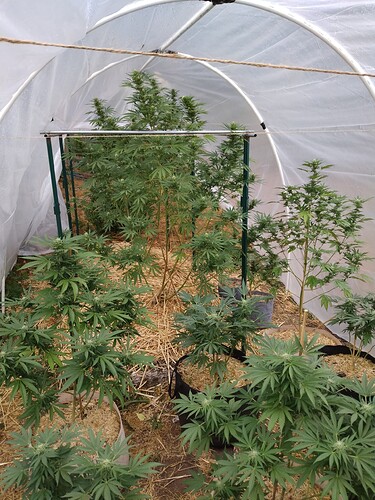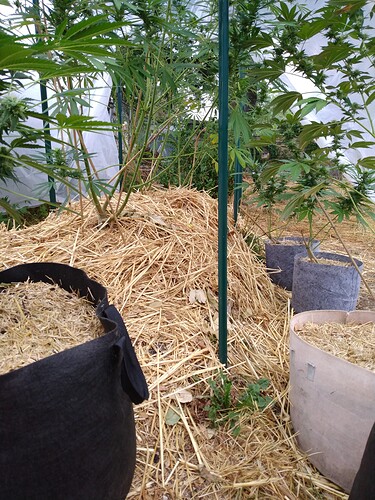Hey there! Any organic cultivators out there using compost/microbial teas or FPJ in your grow? I am looking for any and all recommendations for getting started with these types of organic amendments.
K.N.F.
JADAM is more simplified Organic Kung Fu.
For your organic feedings.
Honey mead fertilizer: I use 1 cup per gallon as I use a pure raw honey with the honeycomb & occasional bee, from Mexico, it’s very very excellent. Has a very long shelf life. & only gets better with time.
For a cutting to become a new plant, it has to be activated by a rooting hormone. Plants produce their own rooting hormone, so if you take a cutting and place it in a glass of clear filtered water, it should start growing roots on its own. That being said, if you want to improve your odds and speed up the rooting process, you may want to consider an exogenous rooting hormone.
Auxins are the most common type of rooting hormone found in plants. Indole acetic acid (IAA) is the kind produced endogenously. Most commercial rooting products don’t use IAA but a synthetic rooting hormone, like indolebutyric acid (IBA) or naphthaleneacetic acid (NAA). These tend to work well, but can have a short shelf life and many growers don’t want to expose their crops to chemicals.
USING HONEY AS FERTILIZER:
Once your plant is fully grown, you may expose it to honey again—this time in the soil!
Plants themselves have no need for glucose, as they produce their own glucose through photosynthesis. That being said, the microflora in the soil can be enriched by it. Soil is full of good bacteria and fungi, and a little bit of honey can help them prosper. Dissolve 5–15ml of honey in a gallon of water, and use this to water your plants. Be careful not to “overload” your soil with honey, as this can backfire and cause damage. Some growers brew their own fertilizer by combining honey, amino acids, milk, yucca extract, volcanic ash, and soap bark extract.
Cannabis can benefit from honey, and happily, honey can benefit from cannabis as well—farmers report that hemp pollen is a valuable resource for bees. Further, honey and weed can combine to form an excellent tincture. It seems these two substances get along on many levels, which works out well for the rest of us.
ONLY REINTRODUCE HONEY TO A FLOWERING PLANT OR DURING A TRANSPLANT TO ENCOURAGE ROOT HORMONES. BUT ALWAYS ADD MYCO IF POSSIBLE TO ENSURE PROPER INOCULATION!
Aloe gel filet concentrate
Amino acids: isoleucine, leucine, lysine, methionine, pheylulanine, threonine, valine, tryptophan, alanine, arginine, aspraragine, cysteine, glumatic acid, glucine, histidine, proline, serine, tyrosine, glutamine, gaspartic acid.
Enzymes: amalase, bradykinase, catalase, cellulose, lipase, oxidase, alkaline phosphate, proteclytiase, creatine phosphokinase & Caboxypeptidose.
Micro nutes: vitamins A, C, E B2, B3, B5, B6, B12, choline, calcium, magnesium, zinc, manganese, chromium, selenium, copper, iron, potassium, phosphorus, sodium.
Lingins & Polysaccharides: galactose, xylose, arebinose, acetylated mannose & acemannan.
(Salicylic acid compounds are good for rooting hormones.)
I typically will filet the gel out of 1-2 large ( 16” leaves) yeilds enough for 3 liters of feed foliar concentrate. Which I use around 5-8 ml per gallon for foliar & 10 ml per gallon for feeding. Can use from first set of leaves off a seed - 2nd to last week of flower.
in addition I always use the foliar after a topping or super cropping due to the healing benefits & hormones from the aloe foliar being so great for the new nodes/laterals/tops to go wild
side note: store in cool dry place, preferably dark, I choose to store in sealed glass containers as they are very reusable & air tight. My solution has never oxidized on me or gone bad, only gets better While stored in proper conditions.
remember if she ain’t foaming you didn’t work er good enough, now let’s keep er movin’
Defoliation FPJ
FPJ, fermented plant juice. Something that is very beneficial to your garden whether it be soil, hydro, rock wool or coco. You can utilize from this to benefit from your own waste in your garden. Just soak add brown sugar or similar glucose, boom set to ferment for 2-7 days. Then strain & you have concentrated FPJ. I use 5ml per gallon. The most important requirement when selecting plants for making FPJ is to use the growing tips of plant species that are fast growers. Flowers, flower buds, and immature fruits can also be used. Hard or woody plant parts will yield little or no plant juice. The plants should be vigor- ously growing at the time of collection. Plant parts should be harvested while the plants are in respiration mode (before sunrise) and not in photosynthetic mode (during daylight), due to the effects these processes have on plant chemistry. Avoid collecting plant parts during or after rainfall (ideally, wait two sunny days after rain stops) and do not rinse collected plant parts, to conserve their surface microbial populations (lactic acid-producing bacteria and yeasts), which will carry out the fermenta- tion process. Low levels of these microbes will result in improper fermentation and/or low yields of plant juice.
Amend soil with bone meal, blood meal, worm castings, crab meal, kelp meal, bat guano, gypsum, & inoculate with myco you’ll have a good bed to thrive with for a while with minimal feeding needed.
I have done organic growing for high-end customers and my wife (same thing!).
KNF and JADAM requires an already rich soil to be effective. I tried bumping up the ppm in teas to hydroponic levels, but it was smelly and encourages all types of life like fungus gnats. The living version of amendments just nuance what is already in the root zone.
A this point, I just keep it simple when it comes to organics. 1/3 humus (compost, castings, leached manure) 1/3 aeration (perlite, rice hulls) 1/3 coco using gypsum or peat using lime.
As far as amendments, I have had great vigor and yield by keeping it simple- corn steep liquor or insect frass as a base, gypsum for calcium, epsom salt for magnesium, organic AGT-50 Fulvic Mineral Complex for fulvic, amino, organic acids and chelated minerals and a dash of cytokinin-dominant kelp for structure going into flower as far as biostimulants.
Use Hydrobuddy to help set nutrient levels. That’s it. No more blending a cubic yard of super soil at a time.
Familiar with KNF, but very much less so with JADAM. What exactly goes into that method?
Thank you so much for all these recs, this is exactly what I was looking for and very grateful for the detailed instructions, I am going to try the honey fertilization for sure! I’ve been using aloe in my cloning process for the salicylic acid, but have not always gotten the most consistent results and rooting timelines I would normally like to see. Do you have any sense for any natural/organic products for exogenous rooting hormones? Any thing like PGPR’s I could try? I was also curious if I should be concerned at all for inviting in and promoting the growth of harmful or pathogenic microbes that may be in my soil when doing something like FPJ or a honey addition. Is there any way to know whether I am inviting the correct beneficial microbes into my system, or is this just a risk one takes with organic feedings?
Just fyi, most honey on any shelf anywhere is fake, in that it has been cut with other sugars. Assume every label to be a lie. You need to find a bee keeper to get the real thing. It doesn’t have to come with dead bees in it, but at least that stuff is real.
Got it! Good caveat that I didn’t think of, thanks for this.
For the rooting hormone, my best runs are done with caps vermiculite tek mixed with a healthy mix of myco in the tray or vermiculite that’s 2” deep, 1/2 tbspof myco & aloe/honey solution in your soak/drench solution for both plugs & stems after being snipped at 45°, insert into plug they place in tray with vermiculite mix half way up cubes (each one).
If you have growth beneath your soil you’re fine, once it starts to show up on top of the soil or medium you have to wet of a environment & not enough dry back time going. Same if you start to see spores forming on your stalk area, try to keep you bases dry about 1/2”-1” around.
As long as you space time inbetween inoculations & keep your environment within good range of temp & rh% you’ll be kosher.
Exactly
KNF uses aerobic fermentation in the production of its organic fertilizers. This process relies heavily on the use of brown cane sugar or molasses. As a result, the process smells pleasantly intoxicating and takes a few weeks. JADAM, on the other hand, uses putrefaction, which is an anaerobic process.

